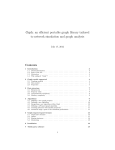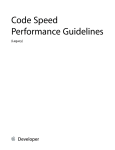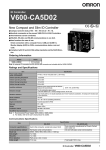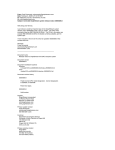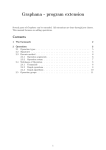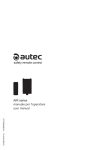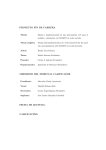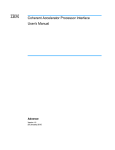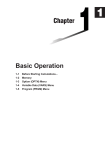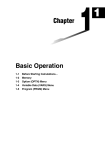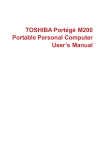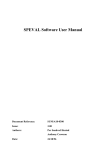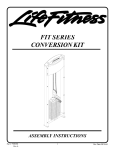Download User manual
Transcript
Grph: an efficient portable graph library
tailored to network simulation and graph analysis
April 11, 2014
Contents
1
Abstract
1
Introduction
1.1
General description
Many scientific and technical fields relate to graphs. Researchers and engineers
who need to programmatically manipulate graph structures have access to a
number of existing graph frameworks [?, ?, ?, ?]. Unfortunately, in spite of the
intrinsic qualities of each specific framework, their all turn out to have strong
limitations in either their execution platform, their computational performance,
the flexibility of their graph model, etc. As a consequence scientists most often
opt for developing ad hoc tools. The very same code is then invariably re-written
by different groups of people, providing the same functionality and exhibiting
the same mistakes. These mistakes include inappropriate design and implementation techniques which lead to poor performance and thereby the unability to
deal with large graphs.
Grph is a Java graph toolkit enabling experimentation on large graphs (in
the order of millions nodes). It proposes a general graph models which supports
directed and undirected simple and hyper-edges in a mixed fashion. Its design
and implementation objectives are geared towards:
• computational efficiency;
• memory efficiency;
• simplicity.
To this purpose, Grph exhibits the following features:
• a data model which represents vertices and edges as positive integers;
• a efficient data structure based on incidence lists;
• implementations for most common graph algorithms;
• a framework for the development of new algorithms and their integration
with Grph;
• a graphical monitoring interface;
• a console-based interactive interface (shell).
2
1.2
State of the Art
Several graph frameworks are available to the graph community. Most relevant
frameworks include Mascopt [?], GraphStream [?], Boost [?], LEDA, JGraphT
[?], JUNG [?], SAGEMath [?], etc.
Briefly speaking, JUNG and JGraphT aim at providing general purpose
Java graph-libraries, featuring decent numerous common algorithms as well as a
GUI enabling the user to plug a graph-tool into their application. Graphstream
focuses on automatic graph layout.
Because these projects have been built to follow specific objectives, they
exhibit different characteristics.
One major objective of Grph is performance. Performance
In this section Mascopt, Jung and JGraphT
Their architecture diverges from what we want to read in Grph. All Java
frameworks (Mascopt, Jung and JGraphT) rely on a cumbersome full OO
model, heading to excessive memory consumption and poor computational performance.
This document focuses on Java software, hence it does not consider greats
tools like Boost or LEDA, which are in C++ or SAGEMath which is implemented in Python, with some slices of C.
Java users can choose in a plethora of frameworks. Most of them are lab tools
which still are at an early stage of their development and would not be used in a
production environment. Mature graph projects include JUNG, Apache Maths
Commons and GraphT stand among the most often used. Unfortunately most
of these frameworks suffer from a lack of support for certain class of graphs
(mixed graphs, hypergraphs), from an often complex design, and from poor
performance. In particular their full-OO design (which allows the construction
Graph<V, E> when V and E can be of any type) imposes their implementation
to rely on hashtables. The immediate consequence of using hashtables in Java
is the large memory usage and slow access time (even is hashtables theoretically
operate in constant time, they prove much slower than arrays).
1.3
Motivation
Our initial motivation for the Grph project was to build up a graph toolkit
that would help us in the frame of a Research project at INRIA labs, whose the
problem was the simulation of large networks. Later we realized the potential of
our graph toolkit to compete with the best ones. Then our motivation changed:
our aim is now to deliver that can help anyone researcher or engineers in need
of graph-related functionality, wether it be in academical research of industrial
context.
1.4
Why calling it Grph?
Why have chosen Grph as the library name. The toolkit was initially called
Dipergrafs because it focused on the manipulation of directed hypergraphs.
3
Since the objectives have somehow changed upon times, the name had to be
adapted to. Now the target model is general graphs mixed in terms of the nature of the edges (simple and hyper) and in their directivity (directed or not).
We opted for “Grph” because the missing ’a’ retains lots of attention and it is
short enough so it can be used within the API.
2
Quick start
The objective of this section is to briefly give the user the hints on how to use
Grph.
The parameters of Grph methods are always checked. To this purpose, and
for the sake of performance, Grph uses assertions.
Unfortunataly, the JVM disables assertions by default. They can be enabled
in two ways:
• by using the -ea flags on the JVM command line;
• or by executing the following line of code before any reference to the Grph
class.
ClassLoader.getSystemClassLoader().setDefaultAssertionStatus(true)
2.1
Creating a graph
To create an empty graph, just do:
Grph g = new InMemoryGrph();
2.1.1
Adding vertices and edges
Adds a new vertex (using the lowest ID available):
g.addVertex();
Adds a given vertex:
g.addVertex(v);
4
2.2
Common topologies
2.3
Displaying a graph
3
Graph model supported
3.1
Topology models
Historically, the initial motivation for developing Grph was to make it useful in
the context of network simulation, considering that networks involve a number
of different technologies that must be modeled in their own special manner:
Ethernet bus, optical links, Wi-Fi/Bluetooth wireless networks, duxplex/full
duplex communication channels, etc. Undirected/directed simple/hyper edges
provide the adequate abstractions to represent this technological variety.
Then Grph comes with a general graph model that supports:
• simple graphs;
• multigraphs;
• hypergraphs;
• any undirected, directed or mixed versions of these (directed hypergraphs
are still under development);
• mixed graphs.
3.2
3.2.1
Data model
Vertices and edges are integers
Most graph toolkits provide models for graphs of objects: they allow vertices
and objects to be of any type. This elegant OO design has a rude counterpart:
it prevents good performance because it requires:
• the computation of hashcodes;
• the use of hashtables, which have heavy memory footprint, and exhibit
slow operation;
• the use of pointers, which require 64 bits on modern computers and add
indirections;
• the user of objects, which have large (at least 12 bytes) overhead.
Grph follows another approach, geared toward performance: it models vertices and edges as numbers. These number are stored in contiguous sequences of
native integer values, which removes the need to hashcode, hashtables, pointers
and objects.
The spaces of identifiers do not have to be contiguous, though the data
structure exhibit de best memory performance when these spaces are dense.
5
3.3
Properties
As said previously, vertices and edges in Grph are not object but numbers. Because of this, the properties for vertices/edges cannot be defined by as attributes
of the the vertex and edge classes.
Grph define a number of basic properties for vertices and edges:
label (string);
color (4 bits);
size (4 bits);
style (1 bit);
These properties all have an obvious graphically representation, and are
actually used in the monitoring view and Graphviz/DOT export method.
These default properties may be used as building blocks for application level
properties. For example, if the users needs a rank property for vertices, he
may want to define a new data structure for the storage of the rank values and
define the corresponding getter/setter methods. A cheaper solution consists as
re-using the size vertex property. Getter/setter methods for the rank property
would then simply make direct calls to the getter/setter methods for the size
property. By using this solution, altering the rank would directly be observable
by a modification of the size of the corresponding vertex on the graphical view.
3.3.1
Pro and cons of storing properties in the graph
The main disadvantage of this model for accessing and storing properties is that
it is not a usual approach of people used to work in Java OO world.
But the advantages are:
• improved memory usage;
• automatic observation of property values;
• automatic search/indexing
3.3.2
Searching properties
The property framework Grph features a function which returns a set of elements that have a given value for a given property. This method is
IDSet IntProperty.findElements(int value)
This function iterates on the set of elements by storing elements that are
found to have the requested value. If the performance of this search function
is critical to your application, you may want to index the value of properties
for set of elements that store it. This strategy is commonly used in database
systems where is it referred to as cursor. A property can be asked to use a
cursor via its setUseCursor(boolean) method. The complexity of the search
operation is then:
6
• Θ(1) if the cursor is used;
• Θ(n) otherwise.
Using a cursor improves the search of elements when the number of element
is large but it significantly slows down the operations:
• changing the property value for elements;
• adding/removing elements from the graph.
3.3.3
Managing graphs of objects
Although this model matches well the mathematical concept of a graph and is
adequate to developments that come atop Grph, many situation still require
the vertices and/or edges to be modelled as objects (for the example when the
data model was defined prior to the decision of using Grph).
Grph solves this issue by providing a bridge from the object world to the
integer world, and the other way around. The class grph.ObjectGrph<V, E>
encapsulates an instance of an integer-based graph and provide the necessary
conversion methods: from IDs to objects (vertices or edges) and from set of IDs
to sets of objects.
Because of the number of API methods Grph available to the developer is
large, the class grph.ObjectGrph<V, E> cannot reasonably bridge all of them.
Grph considers that the conversion methods provided will serve the user at implementing the object-based methods he needs, by bridging the already integerbased methods available.
4
Data structure
Grph comes with one single implementation for the graph data structure which
is based on four coupled incidence lists. It is commonly admitted that incidence
list based implementation perform well when graphs are sparse and that dense
graphs are more adequately represented by matrices. In practice, people dealing with dense graphs are theory animals who seldom opt for programmatic
solutions anyway.
The incidence lists used by Grph store the IDs of incident elements. They
are indexed by the ID of element they relate to. The cell at index n in the vertex
incidence list contains the set of ID of the edges incident to vertex n. This cell
is left empty if vertex n is not in the graph.
4.1
Element sets
Many functions returns set of ID (either vertex IDs or edge IDs). For the sake
of performance Grph may return references to ID sets that are used internally,
instead of returning copies. Altering the content for these set would compromise
7
the integrity of graphs. To this purpose, the returned sets are flagged, indicated
weather they are internal sets.
When dealing with a given set obtained via the use of a Grph method,
it is possible to make sure that the set is not an internal set by calling the
ensureCopy() method.
4.2
Property value
The way the basic property values are stored is up to the developer. Within
Grph, default properties are stored in dedicated arrays which allow small memory usage.
In order to capture the benefit of using this strategy, consider as an example
a marked vertex property that can take two values. The smallest data types
in Java that can be used to store a rank value are boolean or bytes (both are
encoded on 8 bits).
• if vertices were modelled as objects, every vertex would occupy 192 bits
of memory: 12 bytes of Java object overhead) + 1 byte for the mark (but
actual size of the object would be 16 bytes because the size for any java
object must be multiple of 8) + 64-bit reference to the vertex;
• in the case vertices are modelled as numbers, the space required to store
one vertex and its marked is 33 bits: 32 bit integer for the vertex ID + 1
bit for the boolean value (that can be stored in a bitset storing all marked
values for all vertices).
This example, which represents a very common situation, shows a memory usage
that is 5.8 times lower when using integer vertices.
4.3
Computational complexity
This model exhibit the following computational complexity:
number of elements is the number of non-empty cells in the list; since the
number of empty cells is stored and updated on-the-fly, computing the
number of elements simply consists in substracting the number of empty
cells to the actual size of the incidence list; this is done in all case 0(1);
looking up an element is done by checking if a cell a the given index is empty
or not; this is done in 0(1)
adding an element is done by setting a cell at the index given by the ID of
the the element with an instance of an object storing the IDs of its incident
elements; this is done in 0(1);
removing an element is done by emptying a cell at a given index and updating the incident set of its incident elements; this is done in 0(n), n
being the number of elements incident to the element to be removed —
its degree;
8
iterating over the elements in the set is done by sequentially iterating over
the list, ignoring empty cells; this is done in 0(n + m), n being the number
of elements of the corresponding type in the graph and m the number of
empty cells in adjacency list. Most often m tends to zero.
Compared performance shows that using HPPC for manipulation vertices/edges
is 7 time faster than using Java collections when it comes to creating them, and
2.5 times faster when it comes to iterating over them.
4.4
Memory complexity
The incidence of every element (vertex or edge) is represented by an object.
• a simple edge, either directed or not, takes 20 bytes: 4 (ID)+16 (incident
vertices)
• an undirected hyperedge takes 4 + 16 + 12 + n × 4, n being the number of
incident vertices.
• a directed hyperedge takes 4 + 24 + n × 4, n being the number of incident
vertices.
• a vertex takes 4+24 bytes.
– adds 12 + n × 4 if it has n out directed edges;
– adds 12 + n × 4 if it has n in directed edges;
– adds 12 + n × 4 if it has n undirected edges;
A graph with n vertices and m edges takes 24 + n(40 + 4 m
n ) + 20m bytes.
5
Algorithms
Grph comes with implementations for most common graph algorithms as well
as with a framework for the implementation and integration of new ones.
A convention within Grph is that all algorithms are usable through public
methods in the Grph class. These methods can be straight implementations of
algorithms or, better, facility method that call algorithm objects. This design
may be subject to criticism because it leads to a cumbersome Grph class. On
the other side, Integrated Development Environments (IDEs) such as Eclipse or
Netbeans come with code-completion functionality that all users intuitively use
and that make navigation in large source codes easy.
5.1
Defining a new graph property
As detailled in Section, Grph graph come with basic property that should suffice
for most applications: color, size, shape and label. If these properties do not fit
the user need, he may want to introduce new ones.
9
Most graph libraries provide a specific frameworks for the definition of vertex/edge properties. In some case, these frameworks model properties are
key/value pairs and they rely on hash-tables to implement them.
1
2
3
4
5
6
7
8
9
10
11
12
13
14
15
16
c l a s s MyGrph e x t e n d s Grph
{
AutoGrowingByteArray w e i g h t s = new AutoGrowingByteArray ( ) ;
p u b l i c b y t e getEdgeWeight ( i n t e )
{
a s s e r t getEdges ( ) . c o n t a i n s ( e ) ;
return weights . get ( e ) ;
}
p u b l i c v o i d setEdgeWeight ( i n t e , b y t e newWeight )
{
a s s e r t getEdges ( ) . c o n t a i n s ( e ) ;
w e i g h t s . s e t ( e , newWeight ) ;
}
}
5.2
Defining a new algorithm
In Grph, an algorithm is seen as an object.
New algorithms are defined by extending the grph.AbstractGraphAlgorithm
class. Then you need to provide a name, a textual description, and an implementation for you algorithm. At this step, the newly defined algorithm can be
used like:
1
2
MyAlgorithm a l g o = new MyAlgorithm ( ) ;
a l g o . compute ( graph ) ;
5.3
Integrating a new algorithm within Grph
In order to properly integrate a newly implemented algorithm within Grph,
you need to extend the Grph class, like in the following example:
1
2
3
4
5
6
7
8
9
p u b l i c c l a s s MyGrph e x t e n d s Grph
{
MyAlgorithm myAlgo = new MyAlgorithm ( ) ;
p u b l i c MyAlgoReturnType getMyNewAlgoResult ( )
{
r e t u r n myAlgo ( t h i s ) ;
}
}
If you this the new algorithm is of general interest for the Grph community,
you may want to propose it to the author so that it will be integrated into the
core source code.
Write a facility method in the Grph class that calls the algorithm object,
following this pattern:
10
1
2
3
4
5
6
7
8
9
c l a s s MyGrph e x t e n d s Grph
{
p r i v a t e MyAlgo myAlgo = new MyAlgo ( ) ;
p u b l i c i n t getMyValue ( )
{
r e t u r n myAlgo . compute ( t h i s ) ;
}
}
5.4
Defining a LP-based graph algorithm
Linear Optimization functionality is brought via the Jalinopt interface to linear
solvers.
A new LP-based algorithm for Grph is defined by implementing the class
LPBasedAlgorithm. Doing so only consists in defining the linear program
corresponding to the graph problem tackled by implementing the medhod LP
getLP() and T processResult(Result r)
5.4.1
Structured LP. . .
Coming soon.
5.4.2
Forcing the solver
Override method LPSolver getSolver()
5.5
Creating instances with specific properties
5.6
Advanced usage: quest to the maximum performance
Grph makes use of a number if strategies to improve it overall performance.
This strategies are detailed in this section.
5.6.1
Caching
In order to improve even more the computational efficiency for the previously
mentioned algorithms, Grph makes use of a cache.
• Basically, any given property will not be computed twice if the graph has
not changed since then. This improves the complexity of graph operations.
• For example, the computation of all-pair shortest paths will return immediately if the diameter was previously computed . This is because both
algorithms rely on a BFS that was first computed by the “diameter algorithm”.
Depending on the application, performance may dramatically improves.
Practical experiments show that most time is wasted by computing several
times the same algorithms on the same graphs, either directly or not.
11
In order to avoid this, Grph provides a built-in mechanism which stores
the results of calculations until a change occur in the structure of the graph.
Changes include vertex or edge removal or addition. By default, property
changes on vertices or edges are not taken into account (because Grph has
no mean of detecting them).
Consequently, between two changes of the graph structure (it is also likely
that the graph is static, e.g. is will never change), the first invocation of a given
graph operation will be performed in the theoretical time complexity, while
each subsequent one will be performed in constant time — it actually won’t be
performed at all, since the cache will bypass it.
When a change occurs (event the slightest one), the entire cache is cleared.
If you want you algorithm to take benefit of the caching mechanism, you
simply need to wrap it into a CachingGraphAlgorithm object. The following
code does it for you:
1
2
3
4
5
6
7
8
9
c l a s s MyGrph e x t e n d s Grph
{
p r i v a t e MyAlgo myAlgo = new MyAlgo ( ) . c a c h e ( t h i s ) ;
p u b l i c i n t getMyValue ( )
{
r e t u r n myAlgo . compute ( t h i s ) ;
}
}
By doing this, the result provided by your algorithm will be cached until a
topological change occur in the graph. The benefit of the caching mechanism
is higher when the graph is little dynamic and when computations and timeconsuming.
5.6.2
On-demand processing
Processing is done only when the result is requested. This avoids useless processing.
5.6.3
Using native code
Most critical algorithms are implemented in C and compiled to the target machine. These algorithms are called native algorithms. Like all algorithms in
Grph, a native algorithm comes in the form of a Java class. A native algorithm
additionally come with a C file. When the algorithm is first executed, Grph
compiles the C source by using optimizations for the local machine. To do this,
the gcc compiler must be available on the corresponding computer. If the C
code cannot be compiled, an optional alternative 100% pure Java algorithm is
executed.
Many people complain about the poor performance of Java implementations.
Our experiments show that C implementations are about 5 times faster than
equivalent Java ones.
12
Grph provides a framework for the development of C implementations for
graph algorithms. In order to use it, you need to write the C implementation
in the form a set of C functions. Then you need to write a Java interface
declaring these C functions, in a way similar to C header files. Then you need
to extends the AbstractNativeGraphAlgorithm class in order to provide the
translation of data between Java and C. At runtime, the C implementation will
be compiled on the fly using the local C compiler. The resulting native code
will be dynamically loaded and executed.
To write the C code, create a new file called MyNativeAlgorithm.c, aside
to your java source file:
1
2
3
4
5
6
7
i n t e r f a c e MyNativeAlgorithmNativeInterface extends Library
{
i n t computeSum ( i n t n , i n t ∗ v e r t i c e s )
{
// C code . . .
}
}
You need to declare the native function that will be loaded, as shown in the
example:
1
2
3
4
i n t e r f a c e MyNativeAlgorithmNativeInterface extends Library
{
i n t computeSum ( i n t n , i n t [ ] v e r t i c e s ) ;
}
To call the C functions from Java, you need to declare the algorithm class:
1
2
3
4
5
6
7
8
9
10
11
12
13
14
15
16
17
18
19
20
21
22
23
24
25
26
p u b l i c c l a s s MyNativeAlgorithm e x t e n d s A b s t r a c t N a t i v e G r a p h A l g o r i t h m <I n t e g e r , N a t i v e A l g o r i t h m F u
{
@Override
p r o t e c t e d I n t e g e r n a t i v e C a l l e r ( Grph g )
{
( ( M y N a t i v e A l g o r i t h m N a t i v e I n t e r f a c e ) g e t N a t i v e I n t e r f a c e ( ) ) . computeSum ( l i s t . l e n g t
}
@Override
p r o t e c t e d C l a s s <N a t i v e A l g o r i t h m F u n c t i o n s > g e t N a t i v e F u n c t i o n s D e s c r i p t o r ( )
{
return MyNativeAlgorithmNativeInterface ;
}
@Override
p u b l i c S t r i n g getName ( )
{
return ” test native ”;
}
@Override
public String getDescription ()
{
return ” test native ”;
}
}
13
If the native source code is other than C, then you need to specify how to
compile it. For example, the use of C is defined by the single following line:
1
A b s t r a c t N a t i v e G r a p h A l g o r i t h m . c o m p i l e r s . put ( ” c ” , ” g c c
−O3 −o $LIB −s h a r e d − s t a t i c − l c $SRC ” ) ;
The $LIB and $SRC variable will be replaced by the name of the source file
and library file that the compiler will generate.
Better avoid native algorithms.
5.6.4
Data wrapping
In order to avoid the construction new large data structure based on other ones,
Grph makes an extensive use of wrappers. Wrappers are objects that store
nothing but simply redirect call to other data structures.
For example, shortest paths do not store a sequence of vertices. They have
a reference to the distance and predecessor matrices that provide the necessary
information for the shortest paths. This mechanism makes a shortest path of
length 10 weigths 4 bytes instead of 56 bytes, hence 14 times shorter.
5.6.5
Parallelism
Modern computers embed a multi-core processor, enabling threads and processes
to run in parallel. In order to take advantage of this parallelism, whenever
possible Grph split the computation in a number of independant jobs that are
executed in parallel, within distinct threads, on the local computer.
Depending on the algorithms, the speed off varies from near-to-zero to n,n
being the number of processors/cores available on the computer.
Grph comes with a basic parallelization framework for the execution of a
certain class of algorithms: if an algorithm can be decomposed in routines called
independently on every vertex, it may be invoked by the following code pattern:
5.6.6
Disabling assertions
The code of Grph makes an extensive use to assertions. This tends to improve
the quality of the source code. Contrarily to the recommandations, Grph uses
assertions for method parameters checkings too.
This enables the user to disable the assertions, hence disabling all verifications, making the execution significantly faster.
The disadvantage is that the user must not forget to include the following
line before the first call the the Grph class, in order to enable error verification
during the development process.
ClassLoader.getSystemClassLoader().setDefaultAssertionStatus(true)
14
5.6.7
Profiling algorithm implementations
Many researchers in algorithmics are interested in performance issues. In order
to facilitate the study of the performance for algorithms, Grph provides a set
of methods enabling to know the duration spent computing.
The implementations of the algorithms that Grph uses are the ones that
suits better its data structure.
6
Writing fast code
6.1
Iterating
Instead of iterating using IntCursor, like it is done in HPPC:
1
2
3
4
f o r ( IntCursor c : set )
{
int e = c . value ;
}
It is generally faster (although more eager of memory) to first convert the set
to an array and iterate over the array, like this:
1
2
3
f o r ( int e : set . toIntArray ( ) )
{
}
If the set does not change, this method is dramatically faster. If the set does
change all the time, this method is a little slower.
7
Graph import/export formats
Grph provides a set of bridges which make it interoperable with a number
of external tools. This interoperability enables persistence, dynamics, twodimensional rendering (both static and dynamic), etc. The coming sections
detail the interoperability capacities of Grph.
7.1
Grph native formats
Grph natively defines two graph import/export formats: GrphBinary and GrphText.
7.1.1
GrphText: the text Grph Language
GrphText is an extension to the common adjacency list format used by Inet,
CAIDA maps, etc. It extends it by offering the ability to describe:
• directed edges;
• directed and undirected hyper-edges (bus);
15
• half and loose edges (edge with one or no end);
• edge identifiers.
GrphText imposes that vertex and edge identifiers are positive integers. The
directivity of an edge is described by the use of the character >. Edge identifiers
are optional: if they are not given, Grph will assign them itself using the natural
order 01, 2, 3, etc.
The format for an ID, called id is then [0-9]+. The format for an edge
declaration is then:
(id:)?
id* >?
id*
.
As illustrated in the following examples, the compact syntax of GrphText
enables the representation of any graph topology.
The line
1 2
2 > 3
1: 2 > 3
8
{8}
2: {8}
{8 4 5 7}
{8 4} > {5 7}
# a comment
Describes. . .
an undirected edge connecting vertices 1 and 2
a directed edge from 2 to 3
the same, but the edge ID is set to 1
an isolated vertex with ID 8
an undirected hyper-edge that contains vertex 8
an undirected hyper-edge of ID 2, and that contains vertex 8
an hyper-edge connecting vertices 8, 4, 5 and 7
a directed hyper-edge connecting vertices 8, 4 to 5 and 7
guess what. . .
In GrphText, blank lines are ignored. If a # is found, it is assumed that the
rest of the line is a comment.
7.1.2
GrphBinary: the binary Grph Format
GrphBinary provides a compact encoding for graphs.
The number of bytes used for the storage of IDs is computed from the total
number of elements. If less than 28 elements have to be stored, they one byte
will be used to store the IDs. If less than 21 6 elements have to be stored, they
two bytes will be used to store the IDs. Otherwise 4 bytes are used.
The GrphBinary format is based on the encoding defined by java.io.DataOutputStream
and is organized as follows:
1. the name of the graph class;
2. whether the vertex/edge properties will be written in the file or not
3. whether the cached values for algorithms will be written in the file or not
4. the topology, which is decomposed as follows:
16
(a) the greatest vertex and edge IDs;
(b) the number of isolated vertices, following by all of them;
(c) the number of undirected simple edges, then for each of them:
i. its number;
ii. its two adjacent vertices.
(d) the number of directed simple edges, then for each of them:
i. its number;
ii. its source then its destination.
(e) the number of undirected hyper edges, then for each of them:
i. its number;
ii. the number of incident vertices followed by all of them.
(f) the number of directed hyper edges, then for each of them:
i. its number;
ii. the number of tail vertices followed by all of them.
iii. the number of head vertices followed by all of them.
5. the number of graph properties then, for all of them:
(a) its name;
(b) its property-dependant binary encoding;
6. the number of graph algorithms that use caching then, for all of them:
(a) its name;
(b) the Java serialization binary encoding for the cached value.
7.2
Others
7.2.1
Dimacs
7.2.2
LAD
7.2.3
DGS
DGS (Dynamic Graph Stream) propose a language for the description of dynamics in simple graphs, directed or not. Practically a DGS stream (coming
from a file, a URL, etc) defines a sequence of steps in which a number of events
occur. Possible events include: creation/deletion of a node, creation/deletion of
a link, modification of the value for a node/link attribute.
Grph provides DGS drivers which make it possible to:
• animate a graph using the DGS language;
• generate DGS text out of the events which happen on the graph (e.g.
manipulating a graph though its API entails the generation of the corresponding DGS instructions).
17
7.2.4
GraphViz dot
Graph visualization is a way of representing structural information as diagrams
of abstract graphs and networks. Automatic graph drawing has many important
applications in software engineering, database and web design, networking, and
in visual interfaces for many other domains.
Graphviz is open source graph visualization software. It takes as input a
description of a digraph and is able to ouput a variety of popular graphic formats
(both bitmap and vector-based).
Grph comes with a GraphViz driver which allow the user to export the
graph as GraphViz text. In the case of dynamic graphs, only snapshots can
be generated since GraphViz does not consider dynamics. In this case GraphStream can be used.
7.2.5
DotML
Under progress
7.2.6
1
2
3
4
5
6
7
8
9
10
11
12
GraphML
<?xml v e r s i o n =”1.0” e n c o d i n g=”UTF−8”?>
<graphml xmlns=”h t t p : / / graphml . graphdrawing . o r g / xmlns”>
<graph i d =”1220081709” e d g e d e f a u l t =” d i r e c t e d ”>
<node i d =”100” />
<node i d =”98” />
<node i d =”99” />
<node i d =”97” />
<edge s o u r c e =”97” d e s t i n a t i o n =”98” />
<edge s o u r c e =”97” d e s t i n a t i o n =”99” />
<edge s o u r c e =”98” d e s t i n a t i o n =”100” />
</graph>
</graphml>
7.2.7
GML
http://www.infosun.fmi.uni-passau.de/Graphlet/GML/
7.3
Sharing instances
If you wish to share an instance of a given graph, you can store it to a file on
disk and send this file via e-mail. Another solution consists in uploading the
graph using the Grph.post() method. This method will return an URL that
you must give to the people you want to send the graph to. These users will be
able to load the instance via the Grph.loadOnlineGrph(url) method.
7.4
Monitoring
For monitoring purpose, it relies on the simple yet powerful Graphstream.
GraphStream is an open source library which allows the two-dimensional rendering of dynamic graphs. GraphStream listens to graph changes (node/edge
18
creation/deletion and node/edge attribute value modification) and automatically updates the graphical representation. It uses an algorithm providing automatic balancing.
8
Installation
If you plan to use Grph through its API, then you need to download the JAR
files on Grph website and add them to your CLASSPATH.
If you plan to use the experimentation console then you need to install Grph
on your computer by issueing the following command at your shell promt:
curl -s http://www-sop.inria.fr/members/Luc.Hogie/java4unix/j4uni
| sh -s grph
This command downloads the last version of Grph and install it in the
$HOME/.grph directory. The commands will be copied to the directory $HOME/.grph/bin
and the jar files will be in $HOME/.grph/lib.
9
Third-party software
In order to achieve these goals, it relies on the following third-party software:
GraphStream is a dynamic graph visualization toolkit.
HPPC is a framework for efficient manipulation of Java primitive types.
BeanShell
Java4unix
JLine
10
10.1
1
2
3
4
5
6
7
User interaction
Reporting
˜ $ grph−c o n s o l e
Grph g = new InMemoryGrph ( ) ;
g . createVertices (30);
g . glp ( ) ;
Report r e p o r t = new Report ( g ) ;
R e g u l a r F i l e p d f F i l e = r e p o r t . computePDFReport ( ) ;
19
1
2
3
4
5
6
7
8
9
10
11
12
13
14
15
16
17
18
˜ $ grph−c o n s o l e
Grph − t h e u n p r o n o u c e a b l e Graph l i b r a r y . V e r s i o n 0 . 9
C o p y r i g h t CNRS/INRIA/ I 3 S /UNS . 2008 −2011.
Grph> g = new InMemoryGrph ( )
0 v e r t i c e s , 0 edges
Grph> g . g r i d ( 1 0 , 1 0 )
100 v e r t i c e s , 180 e d g e s
Grph> g . g e t V e r t i c e s ( ) . s i z e ( )
100
Grph> g . g e t D i a m e t e r ( )
18
Grph> e x i t
Goodbye .
Figure 1: An example code that computes the diameter of a grid of 100 vertices
1
2
Grph> new InMemoryGrph ( ) . g r i d ( 2 0 , 2 0 ) . g e t D i a m e t e r ( )
18
Figure 2: The same, but minimal.
10.2
Using Grph through its interactive console
Grph provides an interactive console like those that use Python and Perl programmers. The console consists in a bridge between the user and Grph, meaning that the graph routines remain implemented in Java (they are not reinterpreted by the console). This ensure maximum performance.
The Grph Python console can be invoked via the command: grph-console.
This console is based on Beanshell. BeanShell is a small, free, embeddable
Java source interpreter with object scripting language features, written in Java.
BeanShell dynamically executes standard Java syntax and extends it with common scripting conveniences such as loose types, commands, and method closures
like those in Perl and JavaScript. In short, BeanShell is dynamically interpreted
Java.
10.3
Using Grph as a framework
Most Java frameworks suffer exposing their complex architecture to the user.
Basic functionalities are often not accessible easily. In the specific case of graph
library, most of the time functionalities like creating a graph with a desired
topology or obtaining a shortest path require long coding. Grph wants to
avoid this.
Most of the Grph functionality is accessible directly via the grph.Grph class.
20
10.3.1
1
Grph g = new InMemoryGrph ( ) . r i n g ( 5 0 ) ;
10.3.2
1
Computing all-pair shortest paths
g . getAllPairShortestPaths ( ) ;
10.3.3
1
Creating an ring of 50 vertices
Getting a particular path
Path p = g . g e t S h o r t e s t P a t h ( s r c , d e s t ) ;
10.4
Grph UNIX commands
Grph comes with the following command-line utilities. All utilities that accept a
graph description as input allow the user to enable/disable parallel computation
and result caching.
10.4.1
grph-compute-properties
Computes the properties for the given graph. Optionally print their value and
profile the algorithm used for computing them.The properties computed can be
filtered by a regular expression.
10.4.2
grph-convert
Convert the given graph description file to another file.The output format is
guessed by the extension of the output file, given as the second argument.If no
such 2nd argument is passed, then the conversion is done to all output format
supported.These include DHDL, DHDF, GML, GraphML, Inet, etc.
10.4.3
grph-algorithms
Print the list of algorithms available in the library
10.4.4
grph-render-graphstream
Render the given graph using Graphstream. Since Graphstream does not support hyper-edges, half-edgesand loose edges, these will not be rendered properly.
10.4.5
10.5
grph-illustrate-topologies
Grph in Mascotte/COMRED
Grph is a Java graph toolkit. It addresses the computational issues encountered
by several Research topics at Coati, and to a larger extent at COMRED, which
require the programmatic manipulation of large dynamic graphs. In particular,
the study of Internet-like graph properties requires efficient algorithms for the
generation of topologies and for the computation of graph metrics. In addition
to this, the simulation of routing models for the Internet backbone requires the
21
instantiation of large topologies which do not fit in memory when using common
data structures.
A number of graph Java toolkits are already available. These toolkits include
JUNG, JGraphT, Mascopt, etc. Each of these projects is designed to a specific
purpose. Unfortunately none of them aims at performance and suits our specific
needs. To enable experimentation on large graphs (in the order of millions
nodes), and to be useful in the context of Coati Research on networks, Grph
resorts to a number of strategies, not found in other graph toolkits, including:
• its graph models supports directed and undirected simple and hyper-edges
in a mixed fashion;
• its data model represents vertices and edges as positive integers (memoryconsuming object-oriented design is avoided here);
• its data structure is based on incidence lists, fastening the access to the
graph structure (adjacencies, properties, etc);
• it makes use of the parallelism inherent to multi-core processors and multiprocessor computers whenever possible;
• the results of graph algorithms are cached as long as they are valid, thereby
avoiding lots of re-computation (this is particularly useful in the context
of network simulation);
• it uses a compact storage scheme for the serialisation/persistence of graph
topology and properties values;
• it provides a console-based interactive interface (shell), making experimentation more accessible.
The design philosophy of Grph is to keep its code efficient, and easy to
use/understand. The development of Grph is driven by the requirements from
its users — currently researchers and Ph.D students at Coati and AOSTE. We
plan to publicise it for large-scale diffusion.
Grph is registered to APP. It currently has an INRIA proprietary license
whose the main idea is that extern development on it have to be made in collaboration with us. See its website for more information: http://www-sop.
inria.fr/members/Luc.Hogie/grph/
22






















